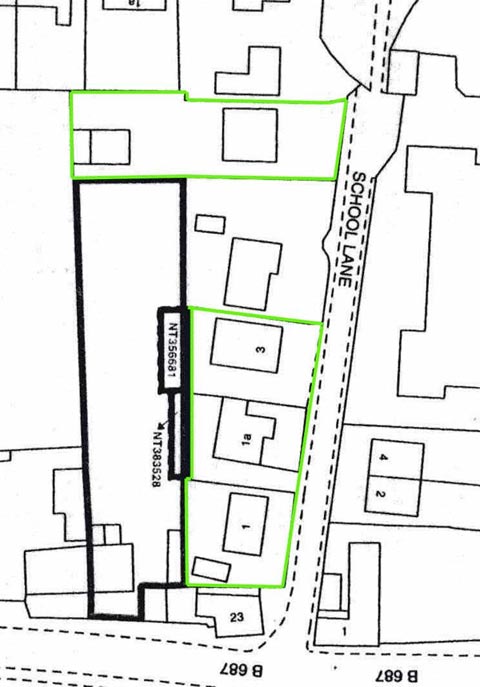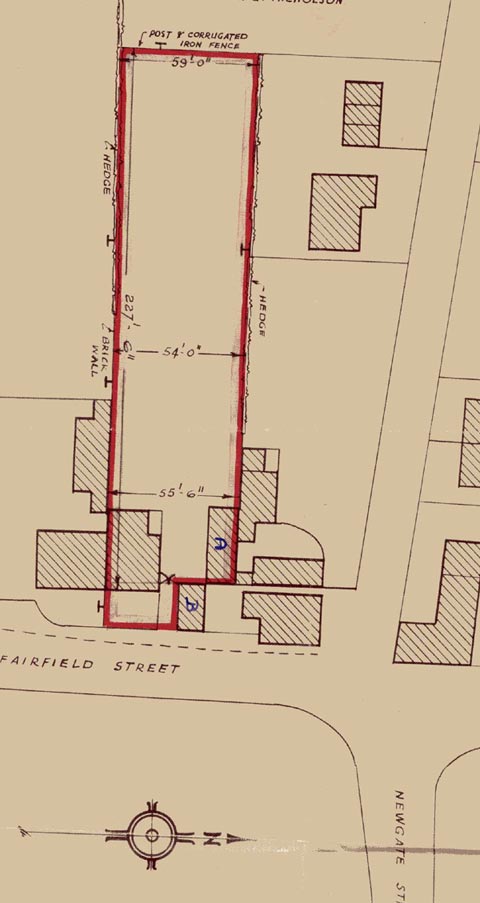![]()
21 Fairfield Street
The early history of the house is revealed in an Abstract of title of Garnet Nicholson from 1958.
On 8th Marcy 1913 the then owner, Henry Swanwick, gentleman, sold the property to Anthony Nicholson, coal merchant. The 1901 census shows Swanwick to have been a a retired pork butcher, aged 47 with his wife Florence aged 38.
The purchase was financed by a mortgage from Ada Harriet Jenkins, widow, of Nottingham. She had previously provided a mortgage to Swanwick, on 20 March 1909. The purchase price of £415 was to be divided £300 to Jenkins, presumably to repay Swanwick’s motgage, and the balance of £115 to Swanwick.
The existence of a mortgage to Swanwick implies the house was already built by 1901. Our analysis of Fairfield Census returns suggests the Gilman family lived here in 1871 and 1881. Robert Hart seems to have been here in 1861. The house seems not have existed before that.
The abstract records the location thus:
All that plot of land containing 1 rood 16 perches (about a ninth of an acre) formerly part of a close called the “Home Close” bounded on
The east by the public road from Langar to Newark (Fairfield Street)
The west by land and hereditaments of Samuel Walker Chettle (see Kirkland House)
The north by land formerly of ? Harding but then of Charles Walker
The south by land formerly of Dorothy Buttery but then of ? Buttery.
The land on the north is the house known as “The Anchorage”. Charles Walker was in the census for 1881 as a shoemaker. Thomas Harding was a miller in 1879. There were two mills in School Lane in the early part of the century. The census of 1871 has Samuel Harding, master miller, and in 1881 his son Samuel master grocer. Walker and Harding would not have been here at the same time, so maybe Walker had moved along Fairfield Street from the Anchorage? They are shown as next to each other in the census. The 1883 OS map implies the existence of a second dwelling on the Anchorage Plot, as indeed does the later plan attached to the documents.
The Butterys mentioned as being south (in the house called Blakeney) are in the censuses for fairfield Street from 1861 to 1891. In 1901 Joseph Baldock, relieving officer for the workhouse lived there.
Anthony Nicholson owned the house until his death in 1917 when it passed to his wife who is noted as living here at Ivy Cottage. She died in 1930. The executor sold the house to Garnet Nicholson for £385, son of Anthony and Elizabeth. Although the municipal cemetery had been open 20 years, the Nicholsons are buried in an elaborately marked grave in the parish churchyard (NW060).
A declaration by Garnet Nicholson dated 26 August 1958 demonstrates his title and was accompanied by the plan at figure 1. He was in the process of selling the house to John Eric Senior for £2000. He retained the long plot at the west end, butting onto School Lane when he sold. This is shown on the plan as owned by Mr Nicholson (the scan cuts it off a little!). This was presumably to allow him to build a house here as well as three houses on the west end of the Anchorage plot – all marked in green on the Land Registry plan at figure 2. An interesting illustration of infill!
Figure 1

Figure 2

He also owned the Anchorage next door, as The conveyance provided for senior to have access over The Anchorage plot to maintain the coach house marked A on the plan and for Nicholson to have similar access over the Ivy Cottage property to maintain his outhouse marked A.
The Seniors sold the house, now known as Newhaven, in 1965 to the Munns for £3500. They sold in 1988 for £75000. It has been sold a couple more times since then.
